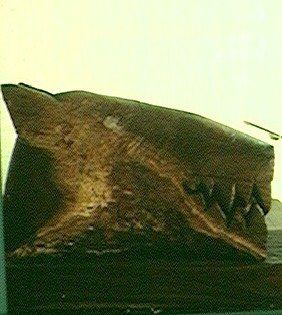

Map Ref. 3. Parkes Place. The mezzanine landing on the stairwell leading down from the Gallery's main front entrance to the ground level of Parkes Place. The work was photographed in 1989 and 1995.
Bruce Armstrong has hewn the features of an animal's head from the trunk of what must have been a huge tree. However, the animal nature of the head, as a wild dog or a wolf, only becomes clear when the work is viewed from below. From this perspective, it is easy to see how the massive log has been transformed into a sculpture which reveals the fierce, tormented spirit within.
The angry spirit inside this sculpture is clearly meant to intimidate the viewer. The beast has only one eye, presumably because the other eye was lost in a fight. To add to the effect, the ears are drawn back in anger and the sharp teeth are bared. Together, these features convey a frightening sense of a beast very much on its guard.
The features of the sculpture have been roughly hewn because it is difficult to work with hardwood, even with the benefit of modern, power tools. All of the bark has been carved away from the trunk, except for the area beneath the chin, where the sculpture rests on three thick planks of the same hardwood. However, a large industrial saw has been used to cut the planks for the base smooth.
The base elevates the head both physically and metaphorically. By contrasting the high finish of the planks used for the base with the relatively rough head, the sculptor has been able to convey his true purpose. The massive tree trunk could have been used for other, more useul purposes, such as to make a piece of furniture. Instead, Armstrong chose to create a fanciful sculpture which seems to contain the spirit of a wild animal. In this, Armstrong pays tribute to the great Renaissance sculptor, Michelangelo (1475-1564), who consciously tried to release the figures he found incarcerated in blocks of marble.